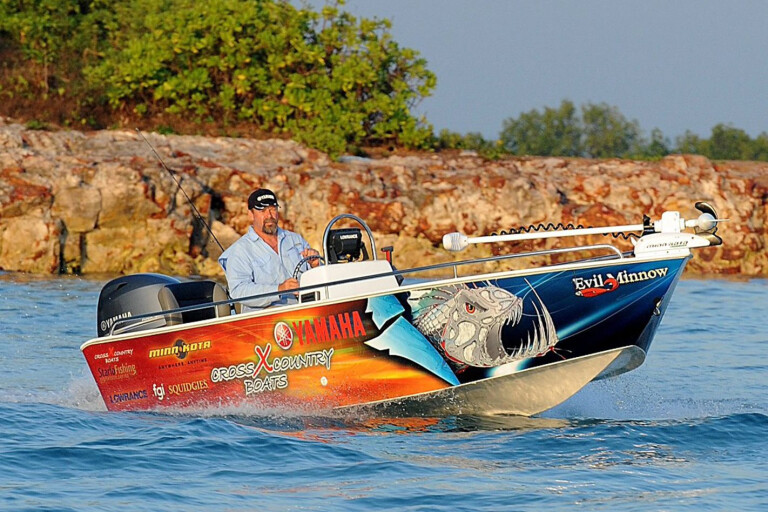
Most Australian boat fishers spend the bulk of their time on estuaries, rivers, bays and harbours.
A good number also regularly visit freshwater lakes or man-made dams. As a result, one of the most popular classes of fishing vessel sold in this country is the ‘semi-flat water’ or estuary rig.
Typically, the hulls of these vessels are between 3.7m and 5.2m in length, with their outboards producing between 15 and 50hp – although, in recent years, there’s been a noticeable shift to more powerful donks, and it’s no longer rare to see pocket-rockets loosely based on the American ‘bass boat’ concept, sporting powerplants with ratings from 60 to 150hp.
My idea of the perfect estuary/freshwater rig is an open boat with a centre or side console, although there’s much to be said for tiller-steer set-ups, especially at the smaller end of the size range under discussion here. Tiller steering opens up a lot of additional workspace in a boat, and that’s important.
My dream estuary rig would have a reasonably modest V-hull up front, transitioning to a flat underside amidships. It should draw no more than 20 to 30cm of water and be stable at rest, even with two adult anglers (three or even four in larger vessels) moving about as they stand and cast.

Without question, my dream rig would run a bow-mounted electric motor; ideally one that boasts a wireless remote control and has GPS-actuated ‘spot lock’ or ‘anchor’ capabilities. There would be a powerful sounder/GPS combo unit on the console or back by the tiller steer position, and there would be a smaller unit up in the bow, where it’s easily visible while casting.
As a dedicated lure and fly fisher, I place great store in having a generous casting deck located in the bow of my estuary/freshwater boat. Ideally, this flat deck would be set as high above the water as practical, taking into consideration stability and safety issues. Every extra centimetre of elevation here adds significantly to the effectiveness of such a platform, increasing an angler’s visibility and casting range.
Having a smaller but functional casting deck in the stern of the vessel is also extremely handy, both for a second or third angler and also on those occasions when it works best to fish over the transom (such as is often the case when using your bow-mounted electric motor’s ‘anchor’ or ‘spot lock’ function to hold the boat in position against tide, current or wind).
 Something my dream boat won’t have is a permanent canopy or fixed Bimini top. Sure, these niceties can be great for escaping the weather (both rain and sun), but in any boat less than 5.5m in length, they’re also guaranteed to adversely affect your casting, inhibit your vision and reduce the vessel’s ability to navigate tight country. If you insist on having a canopy of some sort (this may be desirable if the rig is going to double as a family fun boat), make sure it’s easily removable, or able to be stowed without impacting the vessel’s fishing capacity.
Something my dream boat won’t have is a permanent canopy or fixed Bimini top. Sure, these niceties can be great for escaping the weather (both rain and sun), but in any boat less than 5.5m in length, they’re also guaranteed to adversely affect your casting, inhibit your vision and reduce the vessel’s ability to navigate tight country. If you insist on having a canopy of some sort (this may be desirable if the rig is going to double as a family fun boat), make sure it’s easily removable, or able to be stowed without impacting the vessel’s fishing capacity.
Abundant under-deck storage is highly desirable, as is an enclosed or partly enclosed rod locker capable of stashing half-a-dozen spare rod and reel outfits up to at least 2.2m in length.
If you’re starting to get the idea that my dream estuary rig isn’t the average 4.5m runabout straight off the showroom floor, then you’re right. Rigs of this ilk are relatively rare. A year or two back at the Sydney International Boat Show, I scoured every hall from end to end and found only a handful of set-ups I’d have been happy to take as-is for this role. Incredibly, just two of them were made with my preferred hull material of fibreglass, and only one of those was Aussie-made.
When you consider the thousands of rigs and tens of millions of dollars’ worth of toys on display at a show of that size, it’s staggering so few tick all the boxes in such a popular style of fishing. Perhaps it’s time a few more local boat builders began talking to keen anglers and actually listening to their responses?

COMMENTS